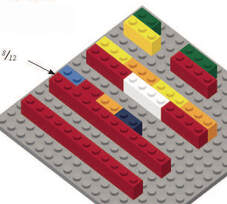 The Brick Math method of learning by using LEGO® bricks to model math problems adapts to anywhere kids are learning – it’s a great method to learn K-6th grade math at home. It makes math easy to teach and fun to learn! Here are the basics you need to know to use Brick Math at home with your own children: Brick Math is taught by math subject. It corresponds to grade level roughly this way: K-2: Counting, Addition, Subtraction 3-4: Multiplication, Division, Basic Fractions, Basic Measurement 5-6: Fraction Multiplication, Fraction Division, Advanced Measurement and Geometry, Decimals Choose the subject(s) you need for your children. You can mix up the grade levels, depending on their interest and what they’re learning. There is a Teacher Edition for each subject for you to use. These have all the lessons in chapter format. There is also a Student Edition for each subject, which is a workbook with extra problems, assessments, and a place to keep your child’s work all in one place. These are optional, but they are really useful. The books come in physical paperback versions as well as PDFs that can be downloaded immediately. The LEGO® bricks that are used to model the math are the common sizes and shapes – 1x1, 2x2, 2x4, etc. Each chapter lists the bricks you need to do the lessons in that chapter, and the appendix of each book has a list of all the bricks needed for the whole program. There is a Brick Math brick set you can purchase, but if you have LEGO® bricks at home, feel free to use them! Brick Math has lots of resources for helping parents teach their children with the program. You can start with video lessons, and then follow the Teacher Edition to guide your child through all the lessons. Every Teacher Edition has tips for teaching with Brick Math. The short assessments in every chapter of the Student Editions will help you make sure your child is learning. And, as always, feel free to contact us with your questions – we’re here to help!
0 Comments
The concept of Least Common Denominator (LCD) is key to being able to add and subtract with fractions that have unlike denominators or compare the size of different fractions. It's essential for students to thoroughly grasp the idea, and until they do so, they can't move forward with fractions. Modeling with LEGO bricks is the perfect way to teach students how to find the least common denominator. This method from Brick Math, called the "Fraction Train," starts with concrete representation of the math problem using bricks, to teach students exactly where the idea of a common denominator comes from.  1. Start by explaining that the process for finding Least Common Denominator with bricks is called the "Fraction Train." Have students build brick models of 2/3 and 3/4. Label them Fraction 1 and Fraction 2. 2. Discuss the value of the numerators and the denominators of 2/3 and 3/4. Ask students if the wholes are the same, and if not, which whole is larger? Explain that you will be finding the Least Common Denominator so you can compare the fractions.  3. Place one 1x3 brick on the baseplate, showing the denominator of Fraction 1, and under that, a 1x4 brick showing the denominator of Fraction 2. Now it's time to start building your "fraction train." You'll be building out a train of bricks that makes a rectangle.  Add enough 1x3 bricks to the top row, and enough 1x4 bricks to the bottom row, until both rows are the same length and the bricks form a rectangle. Count the studs in each row (12) to find the Least Common Denominator—the smallest number that both denominators can divide into evenly. Discuss the fact that 12 is also the equivalent whole for both fractions 2/3 and 3/4.  4. Now it's time to build the equivalent fractions for 2/3 and 3/4, using the Least Common Denominator of 12. Place two 1x12 bricks on the baseplate to represent the LCD of 12 for each fraction.  5. Look at the fraction train again. There are 4 bricks in the top row of the fraction train. This shows the number of 1x2 bricks (from the numerator of Fraction 1) that will model the numerator of the equivalent fraction. Count the studs in the numerator (8) and the denominator (12) . This shows that the equivalent fraction for 2/3 is 8/12.  6. Repeat the process for Fraction 2. Count the studs on the model of the numerator (9) and on the denominator (12). The equivalent fraction for 3/4 is 9/12. 7. Now the equivalent fractions can be compared, since they both have the same denominator. Have students look at the numerators of each fraction and determine which fraction is larger, based on having the larger number of studs in the numerator. Extend the learning by having students draw their models. Have them write a math sentence that compares the two fractions (2/3 <3/4 because 8/12 < 9/12). This lesson from Brick Math's Basic Fractions Using LEGO® Bricks is available FREE as the Brick Math Lesson of the Month for March 2020. Click HERE to sign up for the lesson, including Student Workbook pages.
 Brick Math has just started a Pinterest site, with lots of great images that show how Brick Math works. There is a Pinterest board for each the different math topics covered in Brick Math, including Counting, Addition, Subtraction, Multiplication, Division, Basic Fractions, Basic Measurement, Fraction Multiplication, Fraction Division, Advanced Measurement and Geometry, and Decimals. We continue to add to Pinterest all the time, so check it out today, and make it one of your favorites so new Brick Math pins will show up on your feed. And share this with your friends so everyone can find out about Brick Math! |
Categories
All
Archives
July 2024
|


